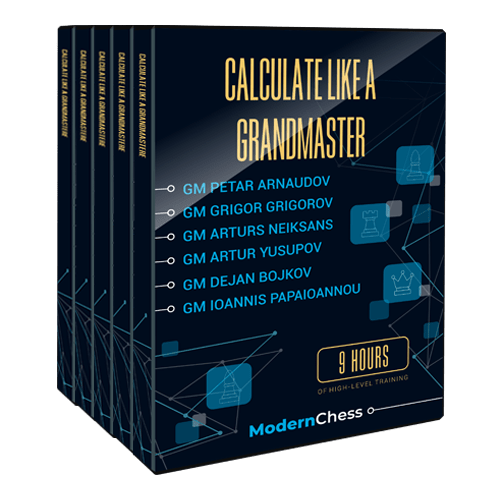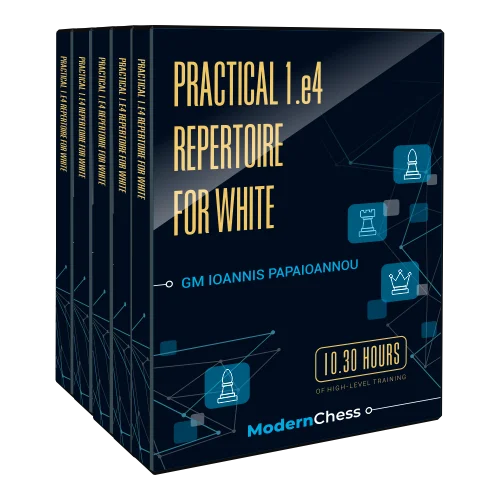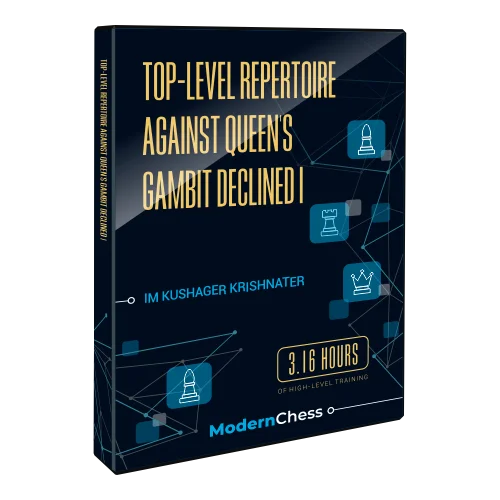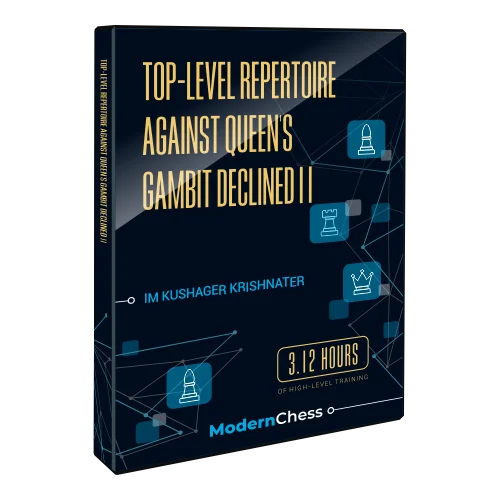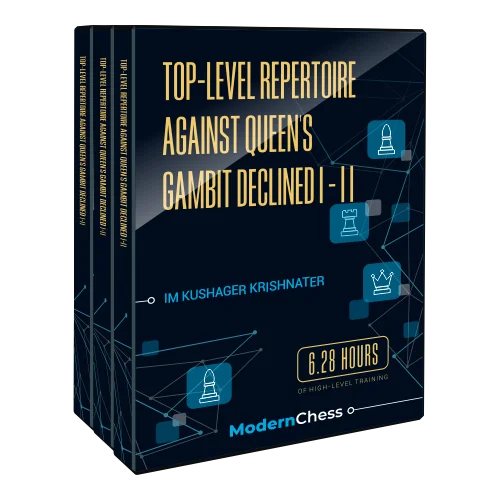The course Calculate like a Grandmaster includes all the videos from the camp as well as the PGN file related to the training sessions. Overall, the material consists of approximately 9 hours of video and a PGN database which includes 153 files!
Introduction:
The course Calculate like a Grandmaster includes all the videos from the camp as well as the PGN file related to the training sessions. Overall, the material consists of approximately 9 hours of video and a PGN database which includes 153 files!
You will find the following lectures:
- Must-Know Calculation Techniques – GM Petar Arnaudov
- Calculation versus Intuition – GM Arturs Neiksans
- Typical Calculation Mistakes – GM Artur Yusupov
- Techniques of Calculating Long Variations – GM Dejan Bojkov
- How to Use Prophylactic Thinking when Calculating – GM Grigor Grigorov
- Realizing Positional Ideas with Calculation – GM Ioannis Papaioannou
Next, we will briefly present some interesting moments taken from the lectures.
What you will learn:
Must-Know Calculation Techniques
In his article, GM Arnaudov shows different calculation techniques and how they work in practice. In 14 exercises from practical games, you will find different tips and ideas on how to improve your calculation skills.
Calculation versus Intuition
Calculating until the end or relying on intuition is one of the most essential dilemmas for all chess players. This lecture by Neiksans tries to provide some valuable insights in that regard.
The author introduces the subject in the following way:
What is intuition? Even though you probably already have your own opinion about that, I would like to share my point of view. In my opinion, intuition is every subconscious knowledge that you already have. Everything that you study and see increases your level of intuition. If you ask me when I have learned the typical bishop sacrifice on h7, I wouldn’t be able to answer. During the years of study and practice, this pattern became part of my subconscious knowledge. From this perspective, it’s easy to give advice to everyone who wants to improve his intuition. You just need to practice and study as much as possible. In this way, you will obviously stock a huge amount of subconscious knowledge.
Nevertheless, intuition is by no means enough. Ideally, you should back it up by solid calculation. Depending on your playing style, you will trust more either your intuition or calculation. Every approach has its own pros and cons. In this lecture, I will provide several examples in order to illustrate how intuition and calculation work together.
Typical Calculation Mistakes
In the introduction to this lecture, GM Yusupov states:
In this lecture, I will try to illustrate the most important calculation mistakes. Of course, presenting them in a systematic way is easier than avoiding them. This lecture aims to point out the most common problems and suggest some ways of dealing with them. In the examples that follow, I will examine the following calculation mistakes:
1) Stop looking for alternatives after finding a satisfactory continuation
2) Missing candidate moves
3) Ending the calculation too early
4) Underestimating the comparison method
5) Keep playing fast once the forced sequence is over (If the first few moves of a given line are forced, we can easily keep playing fast even when a choice appears)
6) Failing to use the elimination method in defense All these points are illustrated with a concrete example.
After studying the examples and watching the videos you will be familiar with the most important calculation mistakes. It goes without saying that further practice is required in order to significantly reduce the number of blunders in our games.
Enjoy!
The PGN version of the lecture consists of 6 extensively annotated examples.
You can try to solve the following position:
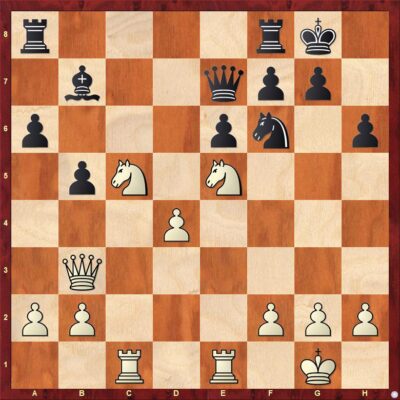
White to move. Calculate 1.Ng6
Techniques of Calculating Long Variations
How many moves ahead can a grandmaster calculate? This is a question that is familiar to any chess player. In this article, GM Bojkov tries to provide some practical advice regarding long calculation.
In the introduction, GM Bojkov writes:
In this lecture, I will try to give some insights into one of the most difficult topics in chess – calculating long variations. I would have been more than happy if could I provide a 100% valid rule featuring the long calculations. Unfortunately, such a rule does not exists. Nevertheless, I will provide insights on how to develop the ability. In the first few examples, you will need to evaluate transitions into a pawn endgame. I advise you to start your calculation exercises with pawn endgames. Since this type of endgames is mainly based on calculation, working on them would be a great warm-up. Then the lecture continues with some more complicated examples taken from studies and practical games. In most of these examples, besides calculating long lines, you should find subtle resources for your opponent. In the video part of the lecture, I explain the thinking process that we should follow when solving such positions. At the end of the lecture, you will find a very interesting type of exercise. You should take a look at a sequence of moves. Without moving pieces, you need to find at which moment a mistake occurred (by Black or White). These exercises are designed to improve your visualization and analytical skills.
Try to solve the following position taken from the lecture:
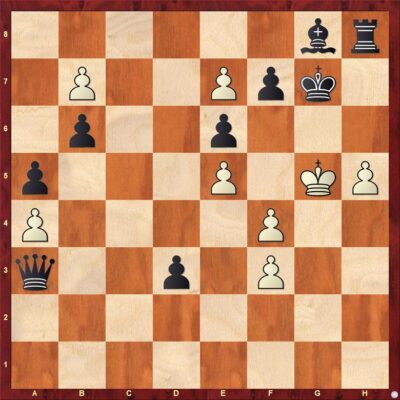
White to move. Try to calculate until the end.
How to Use Prophylactic Thinking when Calculating
In this lecture, GM Grigor Grigorov examines the application of prophylactic thinking in the field of calculation.
Here is how the author presents the topic himself:
Prophylactic thinking is one of the crucial abilities that every chess player needs to develop. At the same time, developing this skill is extremely difficult because in some way we should go against human nature. Subconsciously, we are inclined to think about ourselves, thus neglecting the desires of other people. This instinct was always critical for the survival of humankind. In chess, however, one should always try to put himself in the shoes of the opponent. Considering the opponent’s resources at every single moment is the core of prophylactic thinking. We apply prophylactic thinking throughout the entire decision-making process. Obviously, the calculation of variations is not an exception. An important question is whether there is a smart tool that would help us to identify the resources of the opponent. Different players will give different answers to this question. You can use your intuition, pattern recognition, etc. What worked for me, however, are the so-called indicators of danger. This is a concept developed by the Moldavian theoretician Chebanenko and my former trainer GM Viktor Gavrikov. I have provided extensive coverage of this concept in the masterclass “Improve Your Calculation”
Nevertheless, at the beginning of this lecture, I presented the key points of the entire concept. It’s important to understand that the indicators of danger cannot replace the calculation. They are designed to guide the calculation process. The PGN version of the lecture is divided into different topics featuring prophylactic thinking in the calculation:
1) Looking for Candidate Moves
2) Take-Take Syndrome
3) Conversion of an Advantage
4) Transition into an Endgame
5) Defence
6) Attack
7) Identify the Drawbacks
8) Avoiding Traps
I am sure that after studying the current material, you will get better at identifying the ideas of your opponent. In this way, you will optimize your calculation process.
Enjoy!
Realizing Positional Ideas with Calculation
In his lecture, GM Papaioannou shows the connection between positional ideas and calculation.
In 24 examples he shows how the correct strategical ideas should be supported by correct calculation and accurate evaluation of the arising positions.
You can try to solve the exercises alone and then he can find the solutions at the end of the article.
We bring to your attention one of the positions:
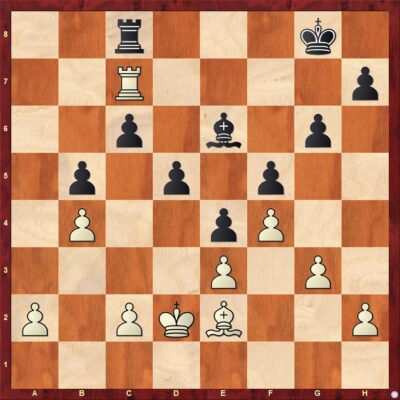
White to move. Calculate 1.Rxc8 as far as you can.
Outline:
Chapter 1. Must-Know Calculation Techniques – GM Petar Arnaudov
Chapter 2. Calculation versus Intuition – GM Arturs Neiksans
Chapter 3. Typical Calculation Mistakes – GM Artur Yusupov
Chapter 4. Techniques of Calculating Long Variations – GM Dejan Bojkov
Chapter 5. How to Use Prophylactic Thinking when Calculating – GM Grigor Grigorov
Chapter 6. Realizing Positional Ideas with Calculation – GM Ioannis Papaioannou
Chapter 7. Q&A Session with GM Grigor Grigorov and GM Petar Arnaudov
